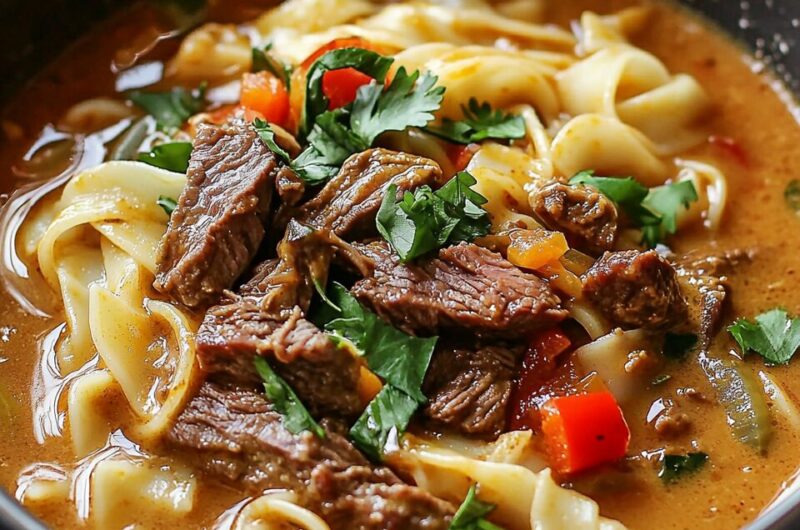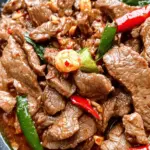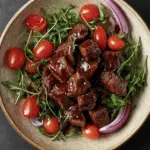The Origin and Influence of Satay in Soup Form
Satay is traditionally a Southeast Asian dish made with marinated meat skewers grilled to perfection and served with a luscious peanut dipping sauce. Popular in countries like Thailand, Indonesia, and Malaysia, satay is beloved for its combination of smoky, savory meat and creamy, spiced peanut sauce. This soup borrows those key elements—especially the peanut richness and fragrant spices—and transforms them into a broth-based dish. The addition of rice noodles and beef transforms it into a hybrid of satay and noodle soup, uniting familiar flavors in an innovative format that feels both new and nostalgic.
Why Satay Beef Noodle Soup is the Ultimate Comfort Bowl
There are few dishes more comforting than a bowl of noodle soup, and this one is no exception. The broth, rich with coconut milk and peanut butter, coats each noodle with a silky, flavorful layer. The beef adds depth and heartiness, while the fragrant additions of garlic and ginger bring a warm kick that soothes from the inside out. Topped with fresh herbs and lime, it delivers complexity and brightness that lift the entire dish. This soup is warm enough for cold days yet light and fresh enough for year-round enjoyment, making it one of the most versatile comfort foods you can make.
Aromatics and Spices: The Flavor Foundation
The bold flavors in this dish come from a carefully balanced blend of aromatics and spices. Minced garlic and ginger form the base, infusing the oil with depth before the addition of red curry paste—an ingredient that provides heat, color, and a medley of herbs and spices in one spoonful. Peanut butter adds that signature satay nuttiness, while coconut milk offers a creamy backdrop that tones down the heat and elevates the richness. Soy sauce ties it all together with umami depth, making each bite deeply satisfying and flavorful without being overly spicy.
The Beauty of Rice Noodles in Asian Soups
Rice noodles are ideal in a soup like this because of their soft, slightly chewy texture that absorbs the broth’s flavors without becoming mushy. They’re naturally gluten-free and quick to prepare, which makes them a go-to base in many Southeast Asian noodle soups. Once cooked and drained, they serve as the perfect canvas to soak up the nutty, spiced broth and offer a comforting bite in every slurp. When paired with tender beef strips, the noodles create a filling yet light meal, striking a perfect balance that satisfies without feeling heavy.
Customizable Toppings and Garnishes
One of the joys of Satay Beef Noodle Soup is the endless opportunity for customization. Fresh cilantro adds a pop of green and herbal brightness that contrasts beautifully with the richness of the broth. Lime wedges are not optional—they’re essential. A squeeze of lime juice cuts through the coconut and peanut butter, lifting the whole bowl with citrusy zing. If you enjoy spice, sliced red chili offers a heat kick. For added crunch and authenticity, top your bowl with bean sprouts and crushed peanuts. These textural elements make the soup even more dynamic and fun to eat.
Health Benefits of Satay Soup Ingredients
Despite its creamy richness, Satay Beef Noodle Soup can be a relatively balanced meal. The beef provides a solid dose of protein, helping with muscle repair and keeping you full longer. Coconut milk offers healthy fats, including lauric acid, which supports the immune system. Peanut butter contributes plant-based protein and fiber, while also supplying essential minerals like magnesium and potassium. Garlic and ginger not only enhance flavor but also offer anti-inflammatory and antimicrobial benefits. When garnished with herbs like cilantro and vitamin-rich lime juice, this soup becomes both healing and nourishing.
Why It’s a Great Weeknight Dinner Option
In a world of busy schedules and limited time, Satay Beef Noodle Soup is a weeknight hero. The total cook time clocks in at around 30 minutes, yet the final dish tastes like something you might order from your favorite Thai restaurant. Most of the ingredients are pantry staples or easy to find in regular supermarkets, and the recipe involves minimal prep and simple steps. You don’t need advanced culinary skills to bring this bowl to life—just a pot, a few fresh ingredients, and a craving for something hearty and delicious.
Tips for the Best Homemade Satay Noodle Soup
For the most flavorful soup, use a high-quality beef broth as your base—it makes a difference in the depth and richness of the final product. Choose tender cuts like sirloin or flank steak, slicing them thinly to ensure they cook quickly and evenly in the broth. Don’t rush the step where the aromatics and curry paste are sautéed; this helps release the oils and deepen the flavor of the broth. If you’re sensitive to spice, reduce the curry paste slightly or add more coconut milk to mellow the heat. And don’t forget to serve the soup hot—this ensures the fat in the coconut milk stays emulsified and the flavors stay vibrant.
Cultural Appeal and Global Popularity
While the recipe is a fusion creation, its core elements resonate across multiple Asian cuisines, making it feel familiar yet novel to a wide audience. It reflects the global appeal of dishes that blend texture, spice, creaminess, and warmth. Satay flavors are universally loved, and combining them in soup form taps into the current trend of reimagining classic street foods as comforting meals. This kind of dish not only honors the spirit of Southeast Asian cuisine but also invites creative interpretation in kitchens around the world.
Conclusion
Satay Beef Noodle Soup is the kind of recipe that turns a simple weeknight into something memorable. It brings together the bold, nutty richness of satay with the soul-soothing qualities of noodle soup. Each element—from the aromatic broth to the tender beef, slippery noodles, and zesty garnishes—works together to deliver a bowl that’s both familiar and fresh. Whether you’re warming up on a chilly evening or just want to treat yourself to a cozy, flavor-packed dinner, this soup hits every note. It’s easy to make, deeply satisfying, and endlessly customizable, making it a must-have in your regular recipe rotation.








